Evaluation of Daily Behaviors Related to Health Risks of the Ger Residents in Ulaanbaatar, Mongolia
Abstract
1. Introduction
- Removal and cleaning of coal ash from ovens
- Packing and disposal of coal ash inside and outside the fence
2. Methodology
2.1. Study Area
2.2. Structure of Questionnaire Survey
2.3. Data Analyses
3. Results and Discussion
3.1. Personal Information
3.2. Exposure Factors
3.3. Living Conditions
3.4. Health Issues
3.5. Social Aspects
3.6. Principal Component Analysis (PCA) Results
4. Conclusions
Author Contributions
Funding
Institutional Review Board Statement
Informed Consent Statement
Data Availability Statement
Acknowledgments
Conflicts of Interest
References
- National Statistics Office of Mongolia. 2018. Available online: https://www.en.nso.mn/ (accessed on 5 May 2020).
- Purev, U.-U.; Hagishima, A. A Field Survey of Traditional Nomadic Dwelling Gers Used as Urban Habitats in Ulaanbaatar, Mongolia. Evergreen 2020, 7, 155–171. [Google Scholar] [CrossRef]
- Byambadorj, T.; Amati, M.; Ruming, K.J. Twenty-first century nomadic city: Ger districts and barriers to the implementation of the Ulaanbaatar City Master Plan. Asia Pac. Viewp. 2011, 52, 165–177. [Google Scholar] [CrossRef]
- Nakao, M.; Yamauchi, K.; Ishihara, Y.; Omori, H.; Ichinnorov, D.; Solongo, B. Effects of air pollution and seasons on health-related quality of life of Mongolian adults living in Ulaanbaatar: Cross-sectional studies. BMC Public Health 2017, 17, 594. [Google Scholar] [CrossRef]
- So, Y.; Lee, N.; Kim, S.; Lee, Y.; Ochir, C.; Lee, K. Characteristics of Lifestyle and Living Environment of Ger District Residents in Ulaanbaatar, Mongolia. Korean J. Public Health 2019, 55, 12–21. [Google Scholar] [CrossRef]
- RTI Human and Ecological Risk Assessment of Coal Combustion Wastes. Available online: http://www.southeastcoalash.org/wp-content/uploads/2012/05/epa-coal-combustion-waste-risk-assessment.pdf (accessed on 5 May 2020).
- Diaz-Loya, E.I.; Allouche, E.N.; Eklund, S.; Joshi, A.R.; Kupwade-Patil, K. Toxicity mitigation and solidification of municipal solid waste incinerator fly ash using alkaline activated coal ash. Waste Manag. 2012, 32, 1521–1527. [Google Scholar] [CrossRef] [PubMed]
- Jang, J.; Ahn, Y.; Souri, H.; Lee, H. A novel eco-friendly porous concrete fabricated with coal ash and geopolymeric binder: Heavy metal leaching characteristics and compressive strength. Constr. Build. Mater. 2015, 79, 173–181. [Google Scholar] [CrossRef]
- Barry Breen; Acting Assistant Administrator; Office of Solid Waste and Emergency Response; US EPA. Testimony Delivered to Committee on Transportation and Infrastructure, Subcommittee on Water Resources and the Environment; U.S. House of Representatives: Washington, DC, USA, 2009.
- U.S. Environmental Protection Agency (EPA). Human and Ecological Risk Assessment of Coal Combustion Wastes; (Draft); (Released as Part of a Notice of Data Availability); RTI: Durham, NC, USA, 2007.
- Regulatory Determination on Wastes from the Combustion of Fossil Fuels (Final Rule). Fed. Regist. 2000, 65, 32218.
- Guidelines for Human Exposure Assessment Risk Assessment Forum U.S. Environmental Protection Agency, 2016. Peer Review Draft. 7 January 2016. Available online: https://www.epa.gov/sites/production/files/2016-02/documents/guidelines_for_human_exposure_assessment_peer_review_draftv2.pdf (accessed on 24 April 2021).
- Sonomdagva, C.H.; Chultem, B.; Byambatseren, C.H.; Enkhchimeg, B.; Batsuren, D.; Batdelger, B. Contamination and Health Risk Assessment of Heavy Metals in the Soil of Major Cities in Mongolia. Int. J. Environ. Res. Public Health 2019, 16, 2552. [Google Scholar] [CrossRef]
- Byambasuren, T.S.; Khuukhenkhuu, B.; Ochirbat, G.; Vasilyeva, I.E.; Shabanova, E.V.; Tsedenbaljir, D.; Korolkov, A.T. Background concentration of microelements in Ulaanbaatar regional natural surface soil. Proc. Mong. Acad. Sci. 2018, 15–24, 15–24. [Google Scholar] [CrossRef][Green Version]
- Battsengel, E.; Murayama, T.; Fukushi, K.; Nishikizawa, S.; Chonokhuu, S.; Ochir, A.; Tsetsgee, S.; Davaasuren, D. Ecological and Human Health Risk Assessment of Heavy Metal Pollution in the Soil of the Ger District in Ulaanbaatar, Mongolia. Int. J. Environ. Res. Public Health 2020, 17, 4668. [Google Scholar] [CrossRef] [PubMed]
- Enebish, T.; Chau, K.; Jadamba, B.; Franklin, M. Predicting ambient PM2.5 concentrations in Ulaanbaatar, Mongolia with machine learning approaches. J. Expo. Sci. Environ. Epidemiol. 2020, 1–10. [Google Scholar] [CrossRef] [PubMed]
- Institute of Geoecology of the Mongolian Academy of Sciences. To Determine the Negative Impact of Sources on Groundwater Quality and Resources in Ger Districts; Institute of Geoecology of the Mongolian Academy of Sciences: Ulaanbaatar, Mongolia, 2013. [Google Scholar]
- Caldieron, J.M. Ger Districts in Ulaanbaatar, Mongolia: Housing and Living Condition Surveys. Int. J. Innov. Appl. Stud. 2013, 4, 465–476. [Google Scholar]
- Ban, H.; Hwang, Y.; Lim, M.; Ochir, C.; Lee, K. Daytime profile of residential PM2.5 concentrations in a ger, a traditional residence in Mongolia. Korean J. Public Health 2017, 54, 23–30. [Google Scholar] [CrossRef]
- Caldieron, J.; Miller, R. Residential Satisfaction in the Informal Neighborhoods of Ulaanbaatar, Mongolia. Enq. A J. Arch. Res. 2010, 7, 12–18. [Google Scholar] [CrossRef][Green Version]
- Cowlin, S.; Kaufmann, R.B.; Edwards, R.; Smith, K.R. Impact of Improved Stoves on Indoor Air Quality in Ulaanbaatar, Mongolia. Energy Sector Management, 2005. Available online: http://hdl.handle.net/10986/18005 (accessed on 24 April 2021).
- Ishihara, Y.; Nakao, M.; Yamauchi, K.; Oomori, H.; Ichinnorov, D.; Solongo, B. Effect of Particulate Matter Air Pollution on the Health Status, Respiratory Symptoms, and Lung Function of Mongolian Living in Ger District and Urban Area of Ulaanbaatar. In C55. Cardiopulmonary Effects of air pollution. Am. J. Respir. Crit. Care Med. 2020, 201, A5415. [Google Scholar]
- Gheorghe, A.; Ankhbayar, B.; van Nieuwenhuyzen, H.; de Sa, R. Mongolia’s Air Pollution Crisis: A Call to Action to Protect Children’s Health; National Center for Public Health and UNICEF: Ulaanbaatar, Mongolia, 2018. [Google Scholar]
- There Is a High Risk of Infectious Diseases. 2016. Available online: https://ubinfo.mn/read/7188 (accessed on 5 March 2021).
- Kamatas, T.; Reichert, J.A.; Tsevegmid, T.; Kim, Y.; Sedgewick, B. (Eds.) Enhancing Policies and Practices for Ger Area Development in Ulaanbaatar. Conference Version. The International Bank for Reconstruction and Development/The World Bank, 2010. Available online: https://reliefweb.int/sites/reliefweb.int/files/resources/5CB73065BD1F6D8D492576DA001F336A-Full_Report.pdf (accessed on 24 April 2021).
- Guttikunda, S.K.; Lodoysamba, S.; Bulgansaikhan, B.; Dashdondog, B. Particulate pollution in Ulaanbaatar, Mongolia. Air Qual. Atmos. Health 2013, 6, 589–601. [Google Scholar] [CrossRef]
- Davy, P.K.; Gunchin, G.; Markwitz, A.; Trompetter, W.J.; Barry, B.J.; Shagjjamba, D.; Lodoysamba, S. Air particulate matter pollution in Ulaanbaatar, Mongolia: Determination of composition, source contributions and source locations. Atmos. Pollut. Res. 2011, 2, 126–137. [Google Scholar] [CrossRef]
- Lim, M.; Myagmarchuluun, S.; Ban, H.; Hwang, Y.; Ochir, C.; Lodoisamba, D.; Lee, K. Characteristics of Indoor PM2.5 Concentration in Gers Using Coal Stoves in Ulaanbaatar, Mongolia. Int. J. Environ. Res. Public Health 2018, 15, 2524. [Google Scholar] [CrossRef] [PubMed]
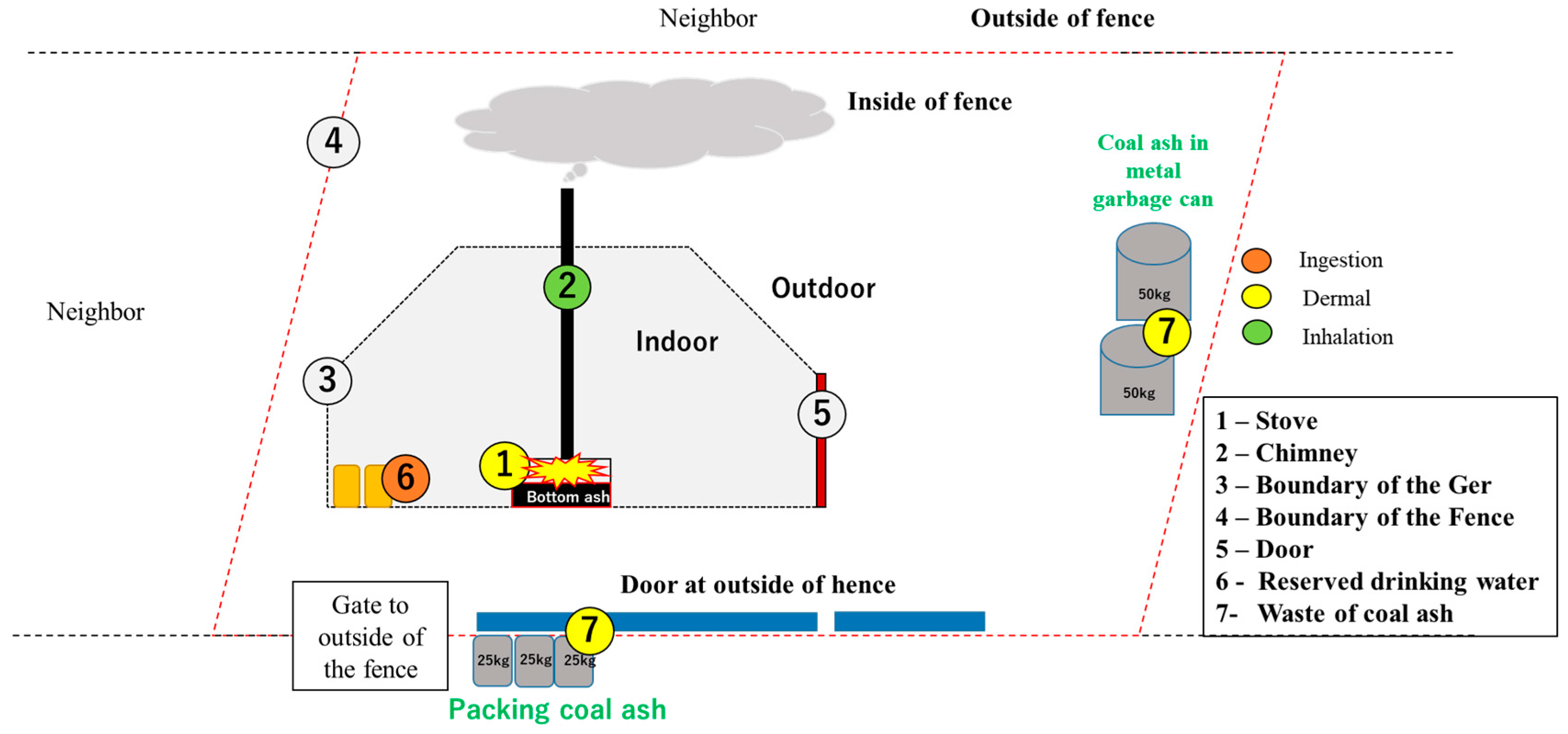
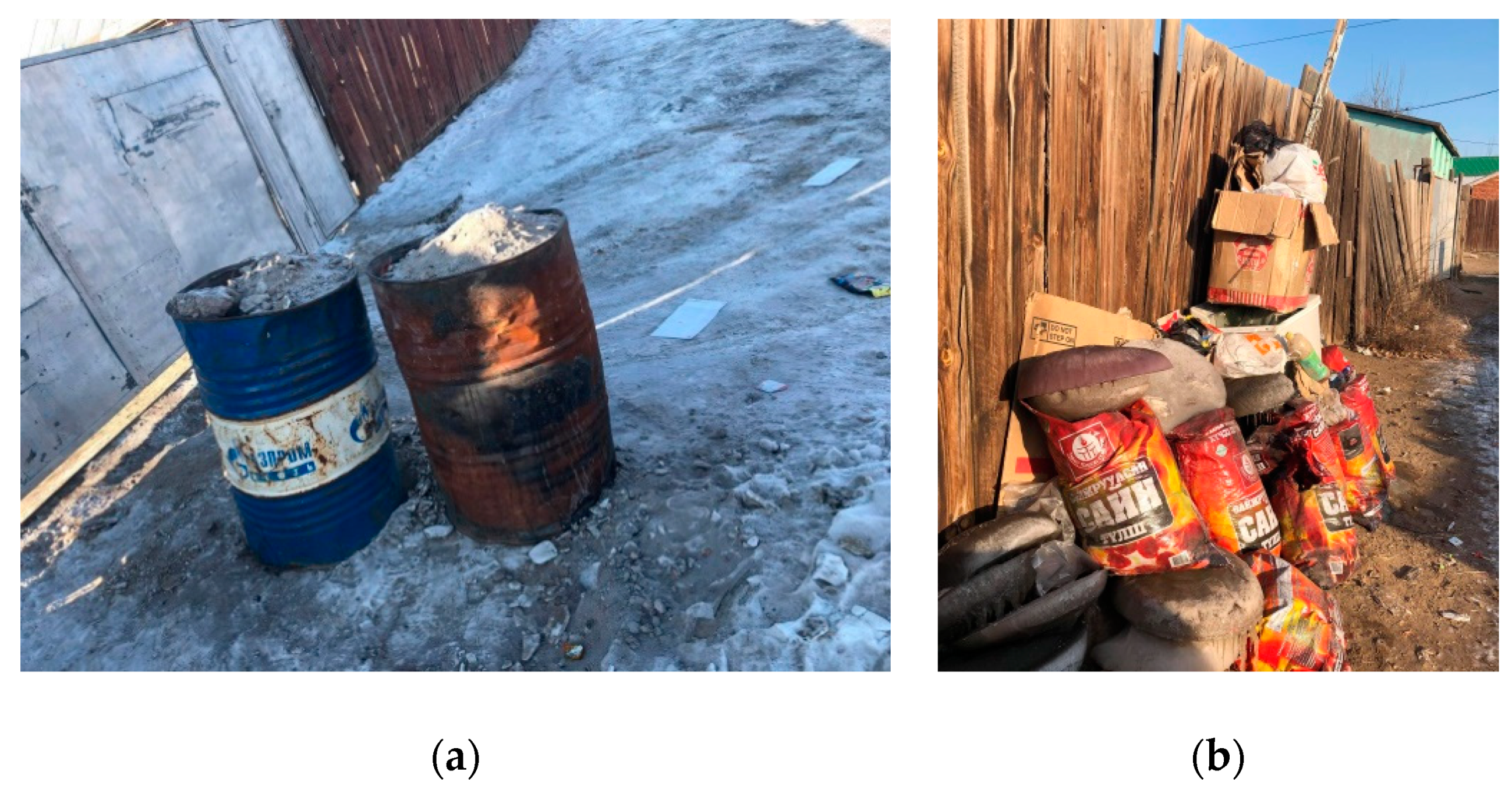
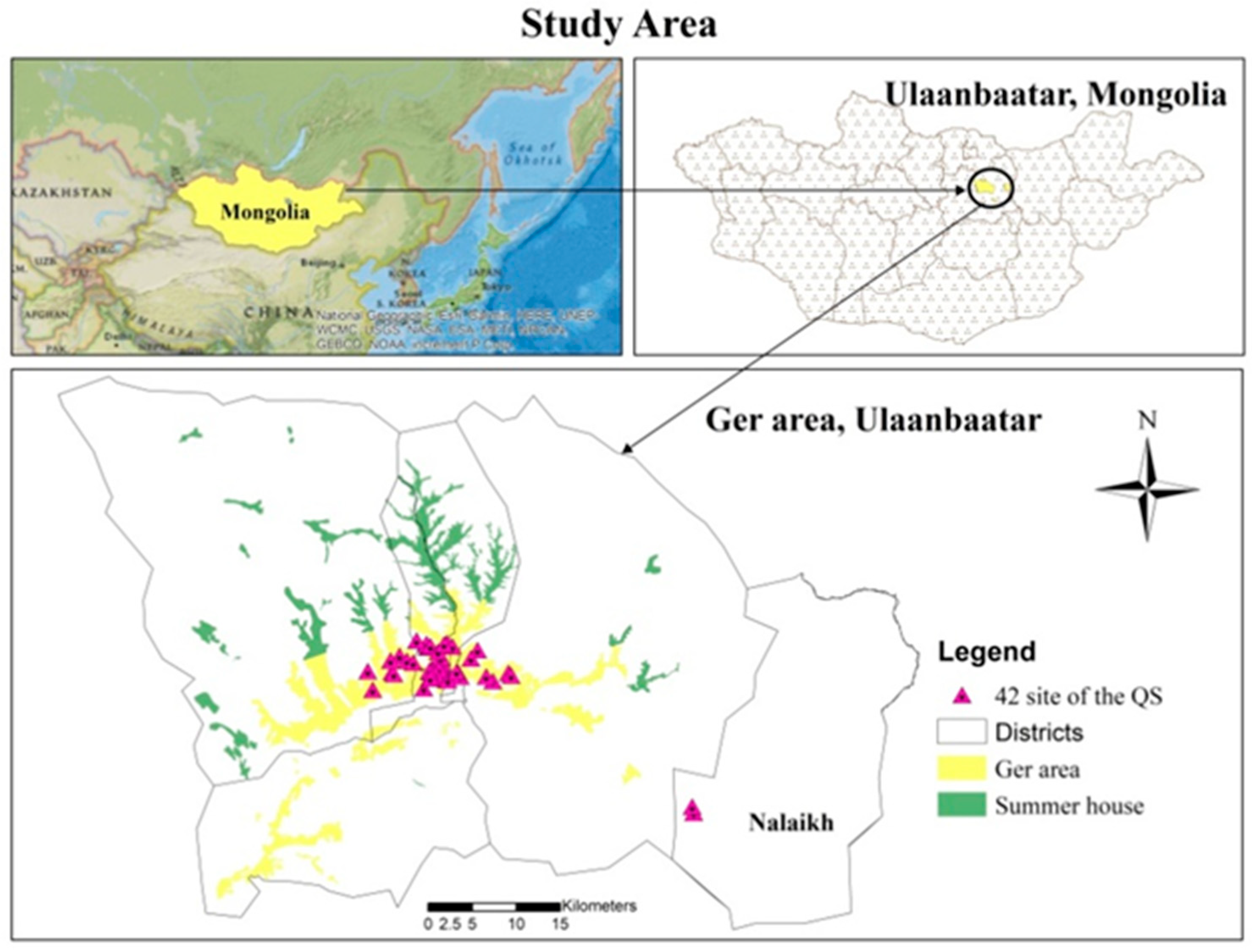
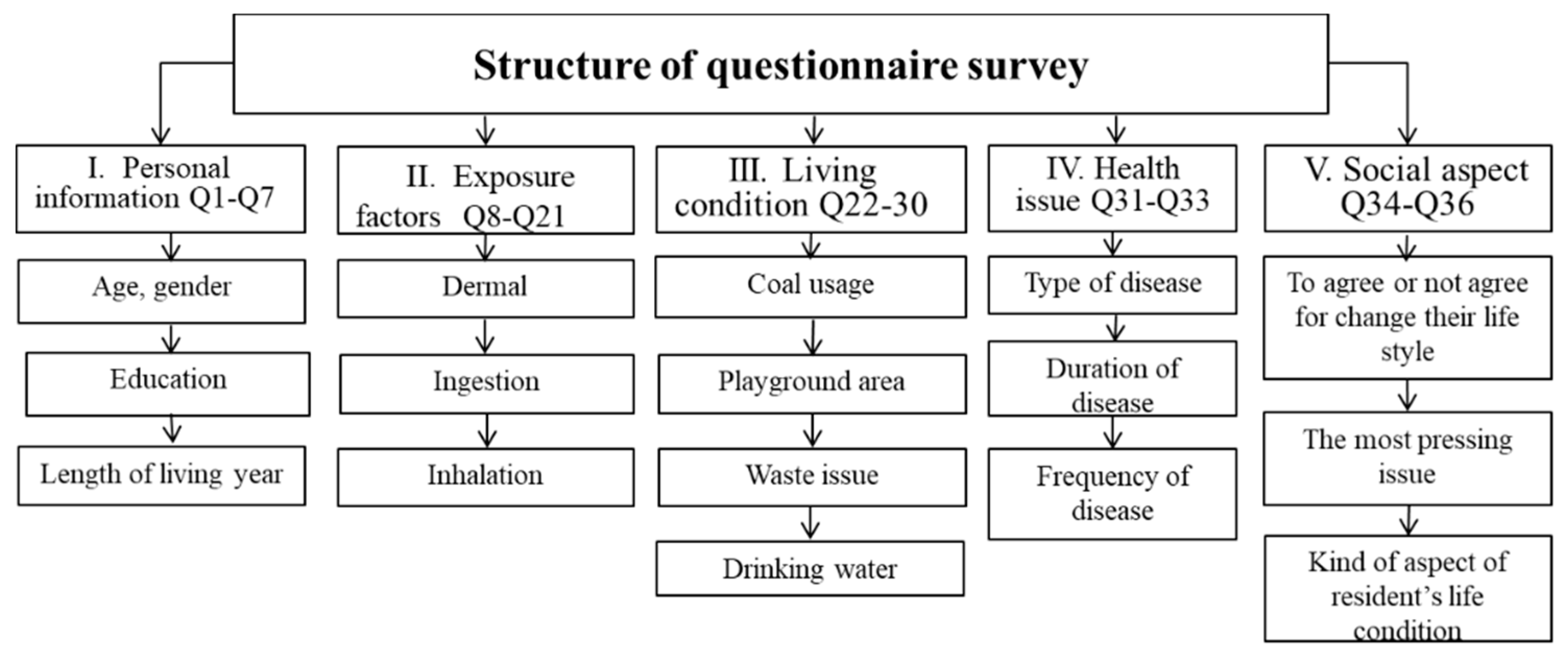
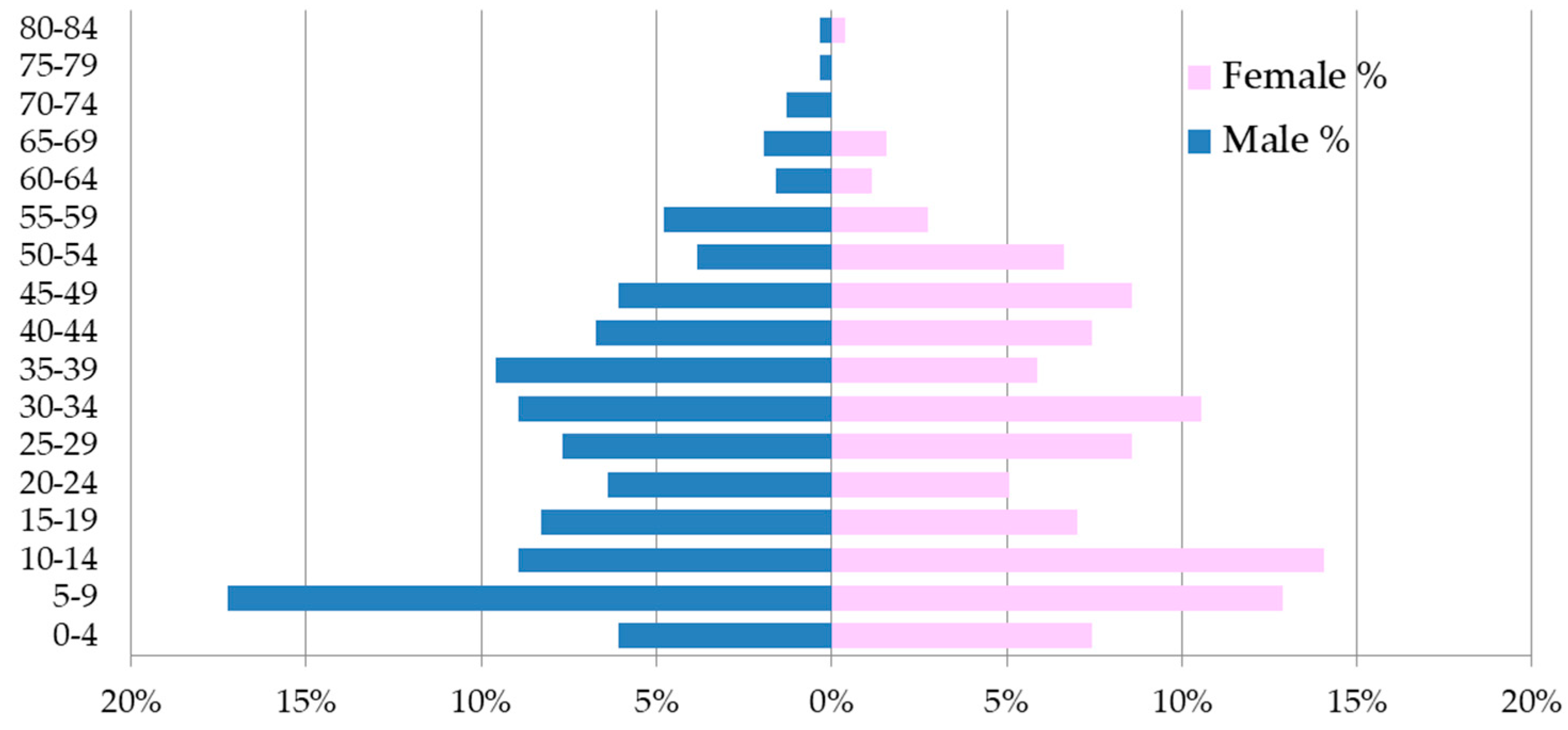
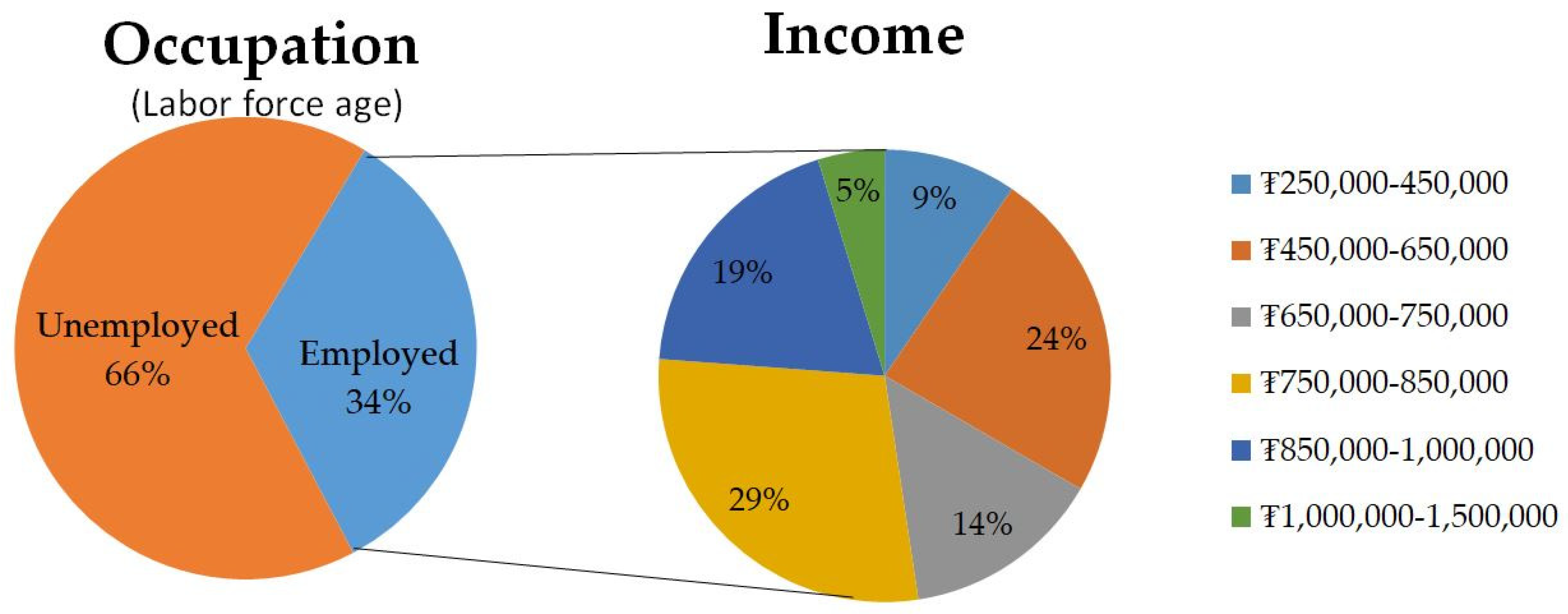
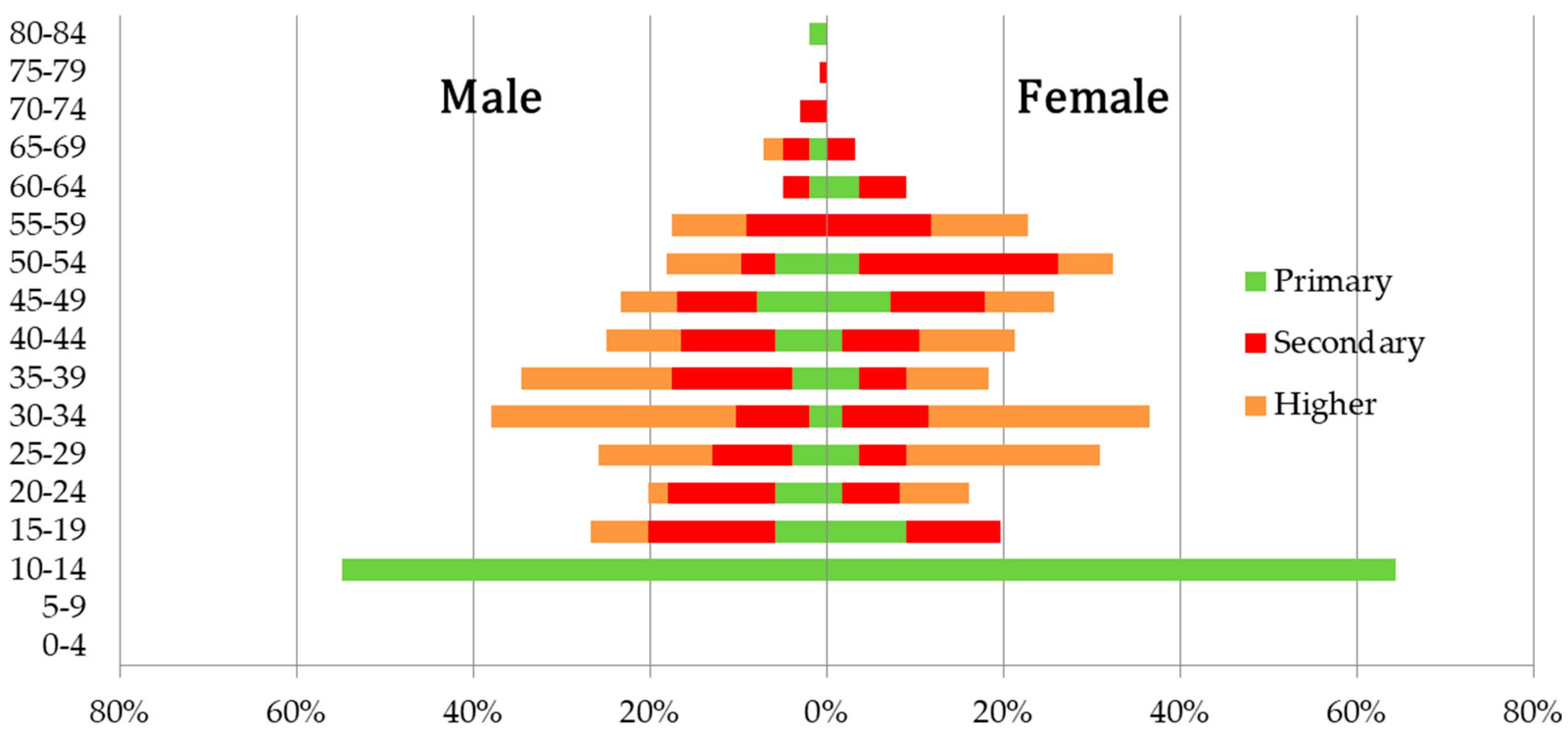
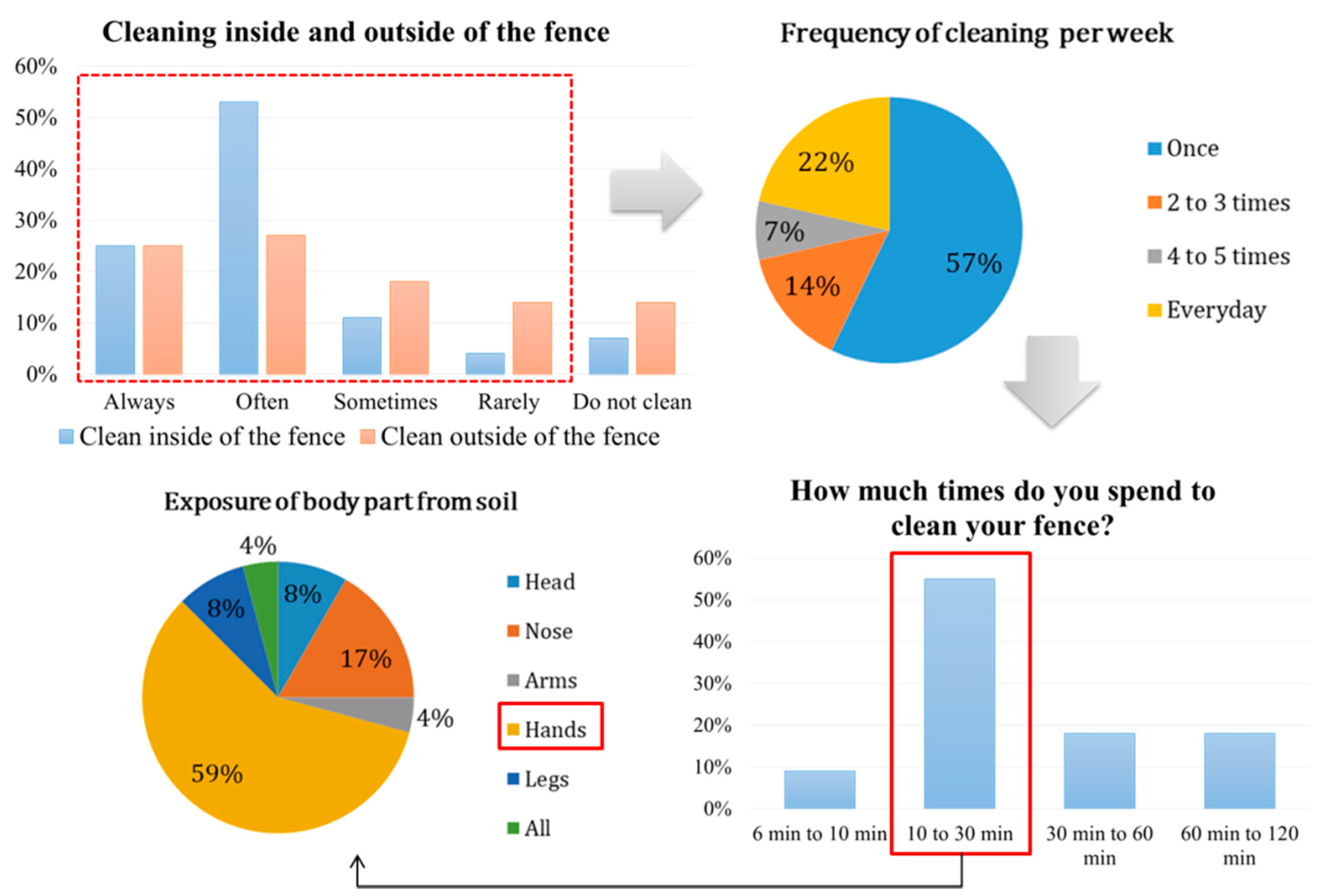




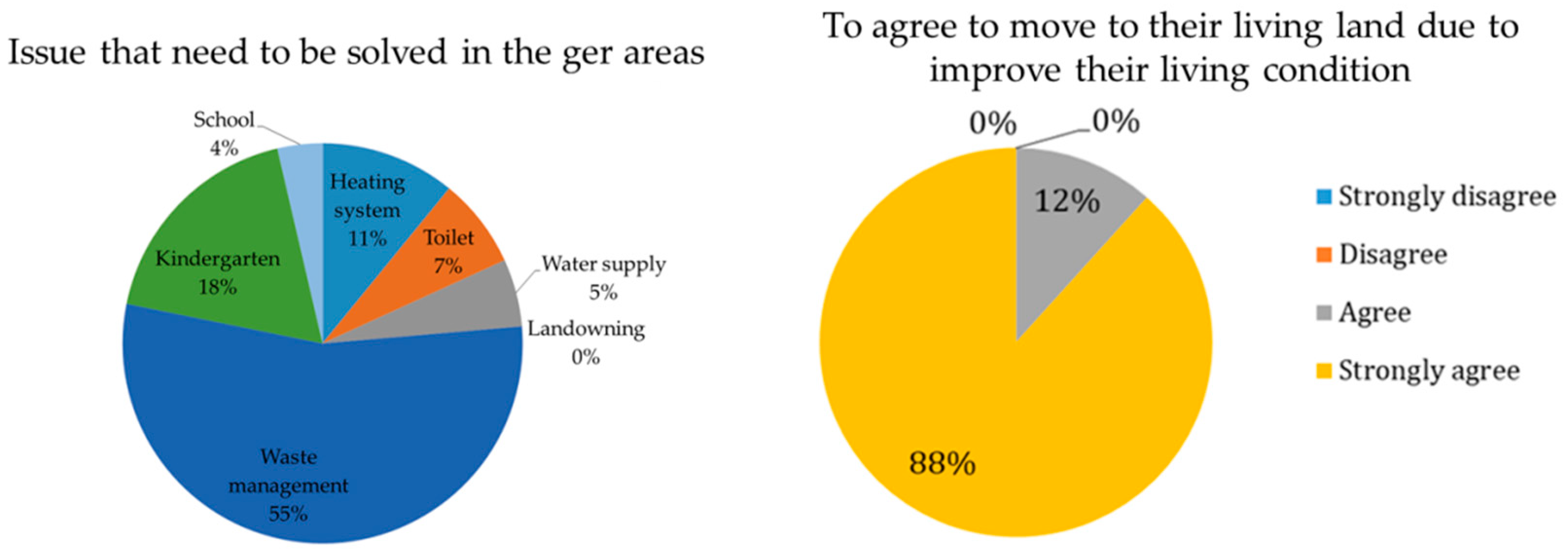
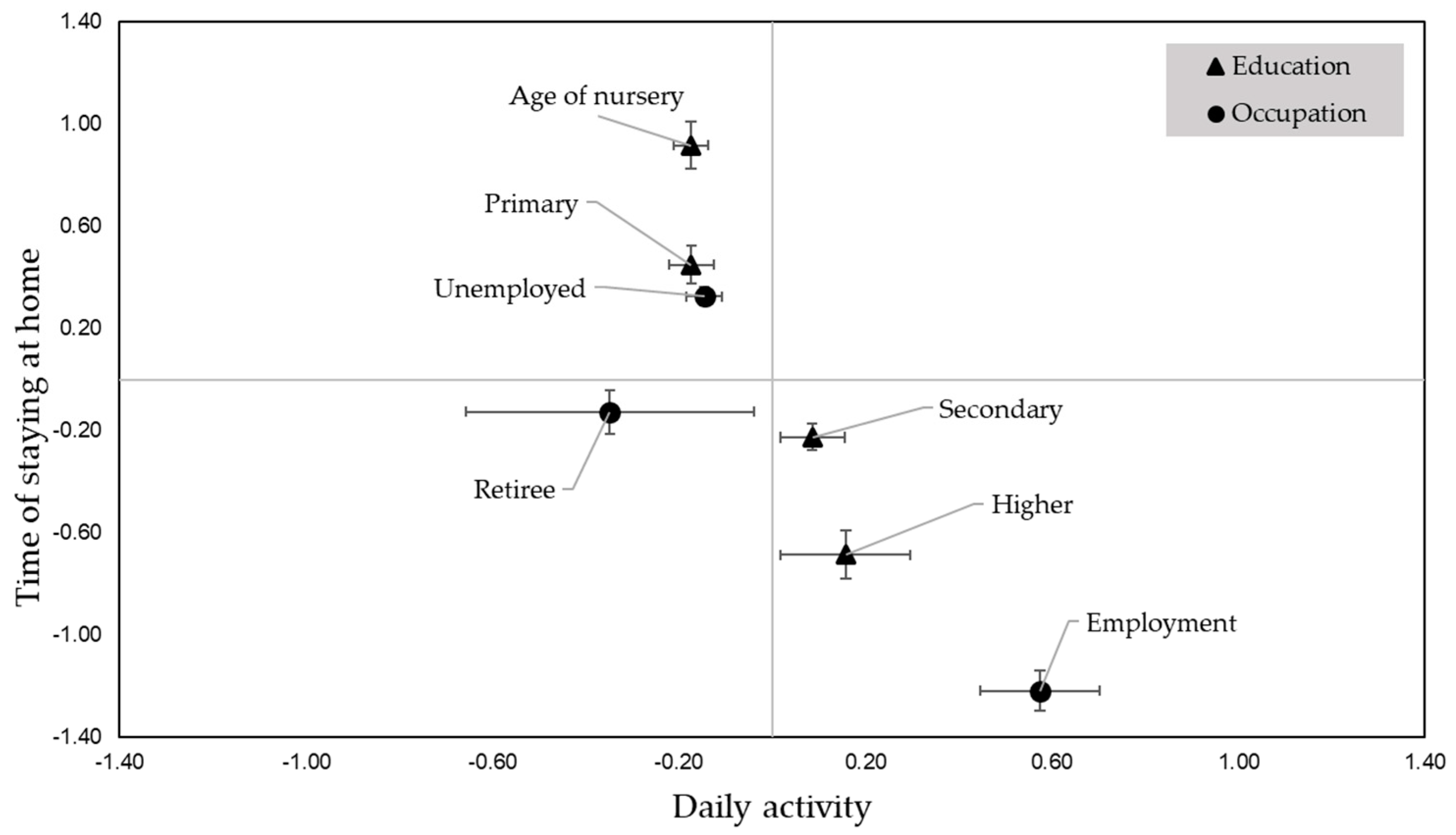

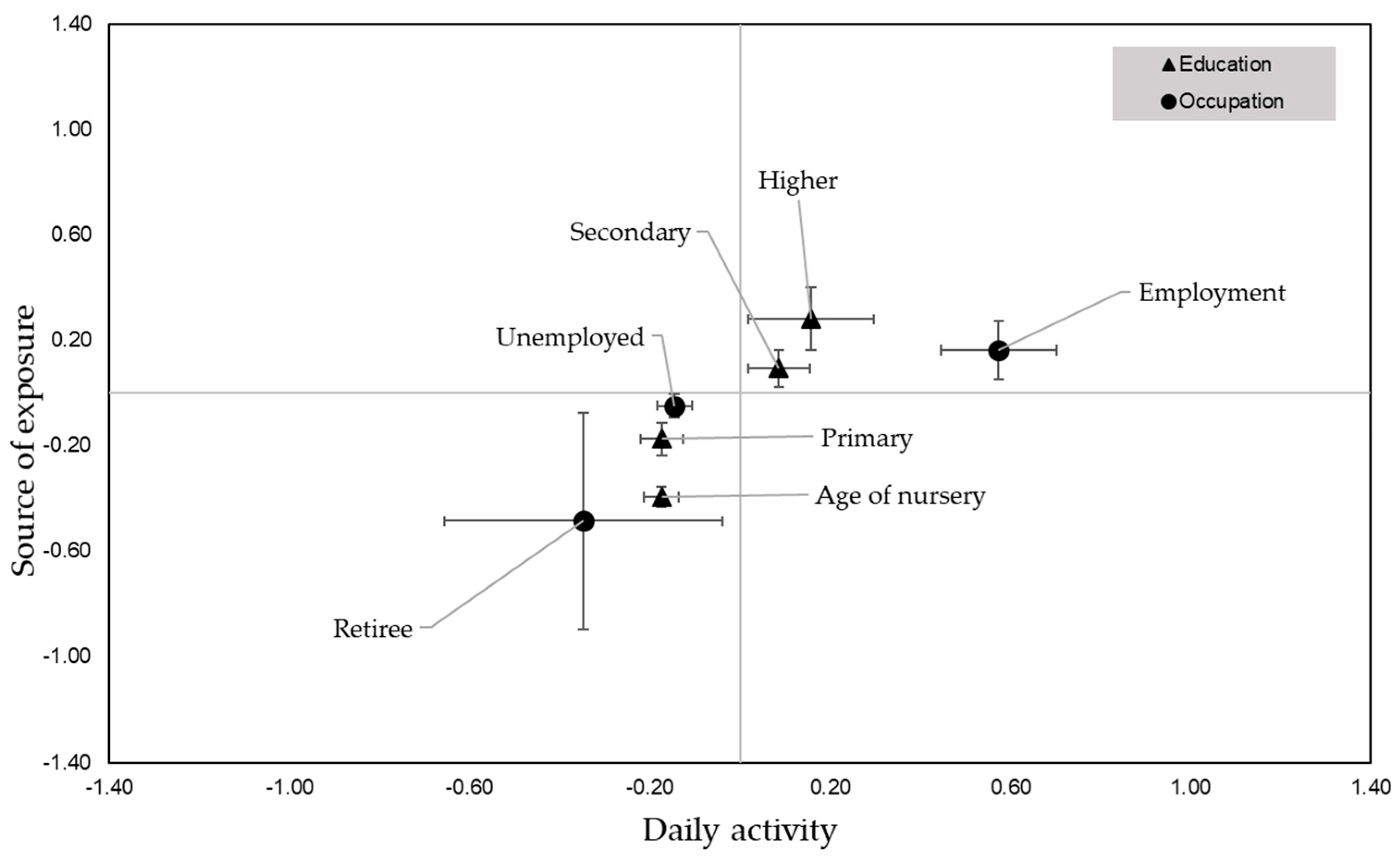
| N | Minimum | Maximum | Mean | Std. Deviation | |
|---|---|---|---|---|---|
| 1. Family members | 571 | 1 | 9 | 2.98 | 1.61 |
| 2. Age | 571 | 0.4 | 83 | 27.1 | 18.22 |
| 3. Education * | 571 | 0 | 3 | 1.61 | 0.90 |
| 4. Length of living location (year) | 571 | 1 | 50 | 11.81 | 8.36 |
| Valid N (list wise) | 571 |
| Component | Initial Eigenvalues | Extraction Sums of Squared Loadings | Rotation Sums of Squared Loadings | ||||||
|---|---|---|---|---|---|---|---|---|---|
| Total | % of Variance | Cumulative % | Total | % Variance | Cumulative % | Total | % Variance | Cumulative % | |
| 1 | 6.711 | 47.937 | 47.937 | 6.711 | 47.937 | 47.937 | 6.566 | 46.899 | 46.899 |
| 2 | 1.326 | 9.474 | 57.411 | 1.326 | 9.474 | 57.411 | 1.306 | 9.332 | 56.231 |
| 3 | 1.109 | 7.924 | 65.335 | 1.109 | 7.924 | 65.335 | 1.205 | 8.607 | 64.838 |
| 4 | 1.042 | 7.443 | 72.778 | 1.042 | 7.443 | 72.778 | 1.112 | 7.940 | 72.778 |
| 5 | 0.909 | 6.496 | 79.274 | ||||||
| 6 | 0.796 | 5.683 | 84.957 | ||||||
| 7 | 0.678 | 4.843 | 89.800 | ||||||
| 8 | 0.454 | 3.246 | 93.046 | ||||||
| 9 | 0.401 | 2.863 | 95.909 | ||||||
| 10 | 0.257 | 1.838 | 97.747 | ||||||
| 11 | 0.141 | 1.009 | 98.757 | ||||||
| 12 | 0.105 | .751 | 99.507 | ||||||
| 13 | 0.066 | .472 | 99.979 | ||||||
| 14 | 0.003 | .021 | 100.000 | ||||||
| Questionnaire | Component | |||
|---|---|---|---|---|
| 1 | 2 | 3 | 4 | |
| 34. To change their lifestyle | 0.898 | −0.185 | −0.080 | −0.019 |
| 35. To collect to idea about changing 4 or not | 0.895 | −0.179 | −0.078 | −0.020 |
| 22. How many kilograms do you usually disposal the coal ash wastes in winter time per day? | 0.882 | −0.150 | −0.076 | 0.007 |
| 17. Do you clean inside of your fence around the home? | 0.868 | 0.109 | 0.351 | 0.010 |
| 19. How many minutes do you spent for clean the fence? | 0.859 | −0.130 | −0.134 | 0.027 |
| 16. Do you clean outside of fence around your home? | 0.856 | 0.082 | 0.350 | 0.024 |
| 20. Do you use the safety items such as gloves and mask while you are cleaning? | 0.831 | −0.033 | 0.128 | −0.053 |
| 18. How many times do you usually clean the fence per week? | 0.829 | 0.121 | 0.412 | −0.001 |
| 29. Duration of keep drink water (day) | 0.746 | −0.255 | −0.254 | 0.072 |
| 14. How many hours do your children play the playground area? | −0.137 | 0.715 | −0.015 | 0.133 |
| 11. How many hours do your family members stay at home per day? | −0.062 | 0.665 | −0.292 | −0.129 |
| 10. If you smoking, how many cigarettes do you or your family smoke per day? | 0.008 | −0.329 | 0.763 | −0.024 |
| 12. How many times do you and your family members pass around the sampling site per day? | 0.008 | −0.130 | −0.056 | 0.759 |
| 8. Do you and your family member’s hand washing before eating food and drinks? | 0.001 | 0.153 | 0.042 | 0.700 |
| Initial Eigen values | 6.56 | 1.31 | 1.2 | 1.110 |
Publisher’s Note: MDPI stays neutral with regard to jurisdictional claims in published maps and institutional affiliations. |
© 2021 by the authors. Licensee MDPI, Basel, Switzerland. This article is an open access article distributed under the terms and conditions of the Creative Commons Attribution (CC BY) license (https://creativecommons.org/licenses/by/4.0/).
Share and Cite
Battsengel, E.; Murayama, T.; Nishikizawa, S.; Chonokhuu, S. Evaluation of Daily Behaviors Related to Health Risks of the Ger Residents in Ulaanbaatar, Mongolia. Sustainability 2021, 13, 4817. https://doi.org/10.3390/su13094817
Battsengel E, Murayama T, Nishikizawa S, Chonokhuu S. Evaluation of Daily Behaviors Related to Health Risks of the Ger Residents in Ulaanbaatar, Mongolia. Sustainability. 2021; 13(9):4817. https://doi.org/10.3390/su13094817
Chicago/Turabian StyleBattsengel, Enkhchimeg, Takehiko Murayama, Shigeo Nishikizawa, and Sonomdagva Chonokhuu. 2021. "Evaluation of Daily Behaviors Related to Health Risks of the Ger Residents in Ulaanbaatar, Mongolia" Sustainability 13, no. 9: 4817. https://doi.org/10.3390/su13094817
APA StyleBattsengel, E., Murayama, T., Nishikizawa, S., & Chonokhuu, S. (2021). Evaluation of Daily Behaviors Related to Health Risks of the Ger Residents in Ulaanbaatar, Mongolia. Sustainability, 13(9), 4817. https://doi.org/10.3390/su13094817






